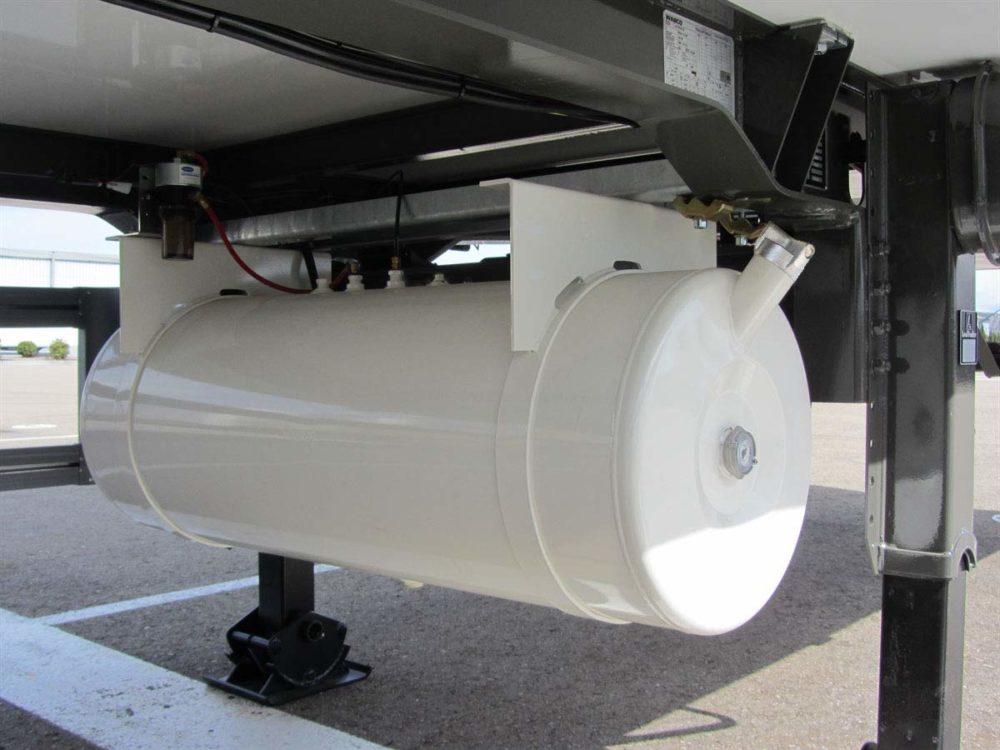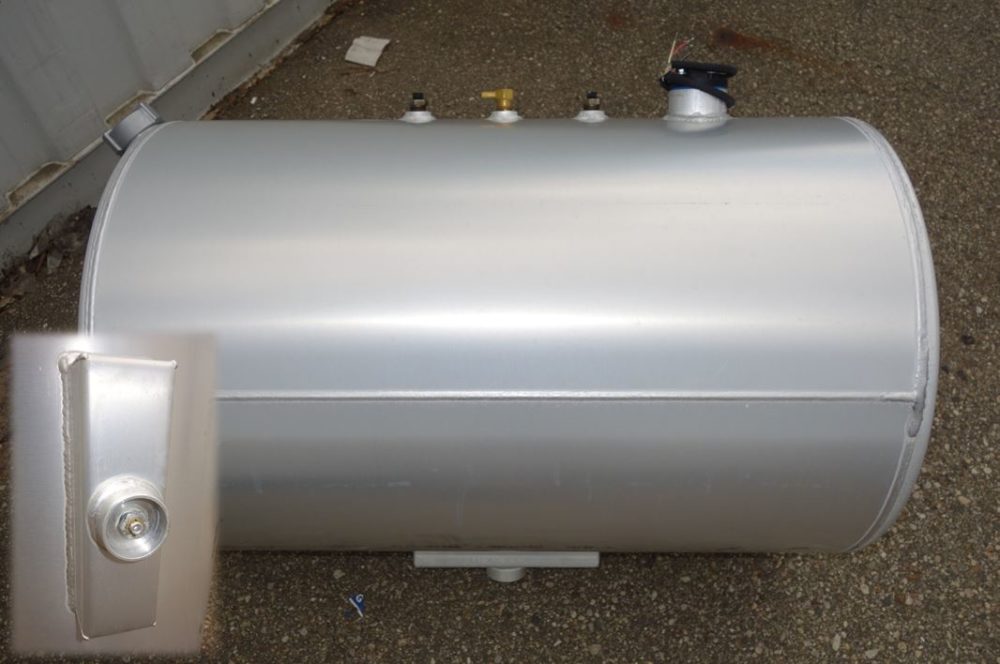Reefer fuel is a type of diesel used in reefer trailers, which carry refrigerants. The particular red-colored diesel keeps the massive refrigerated trailers cold. Because of this use, reefer fuel is illegal in on-road vehicles and trucks. Without it, millions of dollars in products are at risk.

Contents
Reefer fuel has more uses other than just reefer trailers. It also powers off-road vehicles, agricultural vehicles, and construction vehicles. Like other types of diesel, it has a pungent odor.
Still, the unique red dye marks it as a particular fuel with different taxes associated with it, so it’s illegal for on-road use. Further, reefer diesel is a low-quality fuel somewhere between gasoline and diesel.
What Fuel Does A Reefer Trailer Use?
Diesel fuel enjoys a higher energy content per gallon than gasoline. It’s also safer than gasoline, with less explosive vapors. Unfortunately, its exhaust is environmentally unfriendly, and public pressure forces diesel use to decline. Where gasoline rates by octane level, diesel rates by cetane.
Diesel rating comes from its viscosity, volatility, and cetane rating. It breaks down into Diesel #1 and #2 (D-1 or D-2). Where D-1 is thinner and better for winter driving as it doesn’t gel as quickly, D-2 is thicker and better for fuel efficiency. Long-haul trucks use D-2 for this reason, but diesel’s higher energy content allows for heavy load hauling.
Since 2006, the EPA has regulated the sulfur content in diesel fuels. The limit sits at 15 PPM of sulfur for D-1 and D-2 fuels. However, D-2 is premium fuel and has a lower sulfur content than D-1 fuels. A reefer trailer runs off reefer fuel which is a D-2 diesel, just like the standard on-road diesel.
Is Reefer and Diesel Fuel The Same?
Reefer diesel and standard diesel are essentially the same fuel. Reefer diesel is a special classification of diesel that uses a red dye to signify a different tax designation. It finds uses in refrigerated trailers, agricultural equipment, and construction vehicles in an off-road identification. This designation is strictly enforced and can result in fines if reefer fuel powers on-road trucks.
Reefer Fuel Vs. Tractor Fuel
Tractor fuel is another way of saying highway diesel or regular on-road diesel. This diesel is a standard Diesel #2 and is a low–quality fuel. Tractor fuel is not dyed and carries a road tax, whereas reefer fuel does not. Reefer fuel is also ultra-low sulfur, which is different from tractor fuel. Regular diesel powers tractors, but Diesel #1 is the best quality diesel for on-road vehicles.
What Is The Capacity Of A Reefer Fuel Tank?
A standard reefer fuel tank holds 50-gallons, though train cars have tanks as large as 200-gallons. Most reefer tanks burn between 0.4-gallons to 1.1-gallons per hour. The rate depends on various factors such as operating mode, trailer contents, and ambient air temperature.
A reefer tank burns fuel on the lower end of the range with an automatic operating mode. It lasts for several days before needing refueling. It’s best to keep the tank sufficiently full to avoid product loss. In some cases, allowing air into the tank leads to a service call, meaning more lost time and money.
How Do You Fuel A Reefer Trailer?
Video of Filling a Reefer Tank
Refueling a reefer tank for the first time seems overwhelming, but it’s a simple process:
- Pull into a station that sells reefer fuel.
- Locate the tank. It’s usually under the reefer trailer, towards the front. Once you find the tank, unscrew the cap and insert the nozzle.
- Swipe your card at the terminal and select reefer fuel.
Fill the reefer tank until full, then replace the nozzle.
If you’re unsure of the level, there are typically gauges to alert you of the tank level. If not, the next best method is to open the cap and look inside. It’s important to remember that reefer fuel is not taxed and cannot power on-road vehicles. You will incur steep fines if you have reefer fuel in an on-road vehicle.
Can You Run Reefer Fuel In Your Truck?
Reefer fuel is a kind of diesel fuel and needs a diesel engine to function correctly. As a standard diesel fuel, there is no mechanical harm to your truck if you accidentally put reefer fuel in the tank. The most significant risk comes upon inspection, where its use results in fees up to $10,000 in some cases.
How To Start A Reefer Unit That Ran Out Of Fuel?
It’s never a good idea to let your reefer tank run out of fuel. When hauling cargo, running out of fuel means running out of refrigeration, leading to a loss in shipment. Further, a reefer tank without fuel lets air into the line.
When air is in the line, you have to bleed it out and reprime the motor. Otherwise, the system sustains damage and leads to an expensive service call.
To start a reefer unit that ran out of fuel is relatively simple. First, locate the bleed screw and open it so air can escape. There will also be a prime button or switch.
After opening the bleed screw, switch the prime button on and allow the system to restart. Be patient; it is likely the switch needs to be used repeatedly, usually a couple of hundred times at a minimum.
How Much Does Reefer Fuel Cost?
Reefer fuel is like other fuels in that its costs are volatile. It currently costs around $2.99 per gallon of reefer fuel. With global uncertainty surrounding fuels, its likely long-term price per gallon stretches well into the $3.00 range. While taxes are collected upfront, IFTA quarterly taxes allow refunds on the taxes paid at the federal level.
Despite the tax break, reefer fuel still adds considerable overhead to drivers. The average annual expenditure for reefer fuel runs $4,000. Plus, reefer tanks need maintenance that adds an additional $1,500 to $3,000. While there are electric reefer units, reefer-fueled units are still the industry standard. The costs aren’t likely to ease any time soon.

Final Thoughts on Reefer Fuel
Reefer fuel is short for refrigeration fuel and powers cold trailers. While it powers cooling or reefer trailers, reefer fuel also powers agricultural equipment, construction equipment, and off-road vehicles. These trailers transport goods across the world and prevent countless products from spoilage.
Reefer fuel is a particular type of diesel fuel that does not have taxes like regular diesel. Regardless of the red dye and special tax designation, reefer fuel is like regular diesel and will power any diesel engine.
Because of this special tax designation, reefer fuel isn’t allowed for use in on-road vehicles. Using reefer fuel this way results in steep fines.
Paying for reefer fuel comes with an extra step. Reporting reefer fuel purchases during quarter tax returns allows a refund for the taxes spent. While this benefit is helpful, the extra fuel needed and maintenance costs add additional overhead for drivers.
FAQs
Reefer fuel is a special type of fuel, so questions regarding its use are expected. Here are a few of the most common questions about reefer fuel.
Is reefer fuel dyed?
Yes, reefer fuel is dyed red to distinguish it from other diesel types. By dying it red, it is easier to identify for those who drive vehicles that specifically need to use that kind of fuel.
The red dye also leaves a red residue in engines. Because it is illegal to use reefer fuel in on-road vehicles, if that residue is found upon inspection of that kind of vehicle, the driver will receive a fine.
Is reefer fuel bad for diesel engines?
Reefer fuel is a Diesel #2 fuel which is considered low-grade. Aside from this classification, reefer fuel will not mechanically damage diesel engines as it’s not fundamentally different from standard diesel fuel.
Is reefer fuel off-road diesel?
Reefer fuel is considered an off-road diesel. This classification means it’s legal to use in off-road, agricultural, construction, and reefer tanks for trailers. In addition, vehicles that do not travel on public roads are considered off-road vehicles and can use reefer fuel for power.
How long will a full tank of reefer fuel last?
A full 50-gallon tank will burn between 0.4 and 1.1-gallons of fuel per hour. Even at the worst rate, an average tank will last over two days of constant use. With automatic operation and under best-case circumstances, a reefer tank will last around five or more days.
How many times do you need to fuel the reefer tank?
Keeping the reefer tank full is vital for proper function. Depending on the rate of consumption and the type of functions your reefer trailer uses, you will need to refuel your reefer tank every 48 hours to five days.
It’s important to factor in the distance to the destination and how long you will have a product in the trailer. An empty trailer won’t require fuel.
Where is the reefer fuel pump located?
Reefer trailers have dedicated tanks for reefer fuel and are attached to reefer trailers. Typically, reefer tanks occupy the underside of the trailer towards the front of the trailer. This location helps distribute the weight of a full tank.
What is the average fuel consumption of a Thermo King reefer unit?
A Thermo King uses more fuel than average units hitting a best of 1.03-gallons per hour. Of course, these results happened on fourteen tests over only a two-day period, and real-world results prove the Thermo King receives a more fuel-efficient rating.
Other ratings point to a rate closer to 0.74-gallons per hour during real-world circumstances.
What is the best reefer engine brand?
Few brands stand up to Thermo King and Carrier regarding reefer units. Thermo King has a rich history of producing quality reefer units and sits atop the market in commercial refrigeration units.
A close second is Carrier which delivers consumer and commercial cooling units. Both companies provide quality units and excellent product support, but they command a higher price than the competition.




